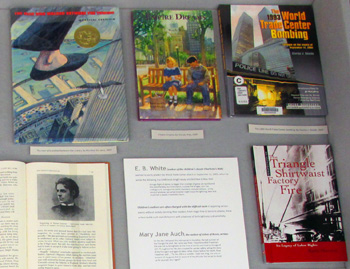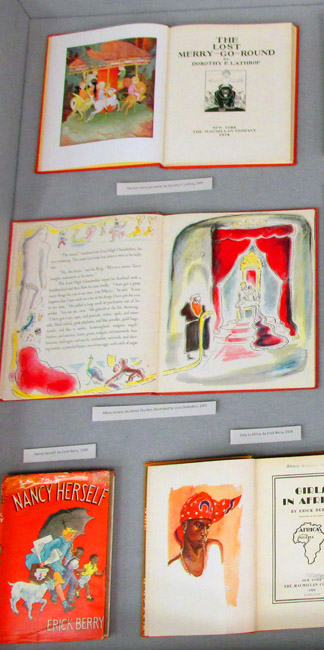Below is the text that appeared in the three main display cases during the exhibit (July 2013), as well as lists of all the books that were on display.
New York City Books | Erie Canal and Western NY Books | Albany Books| Additional Books
The Statue of Liberty has an engraved bronze plaque on the pedestal, showing this famous poem by Emma Lazarus, who was born in New York City in 1849. Although her family had lived there since colonial times, Lazarus showed a remarkable empathy for those newly arriving in America:

Not like the brazen giant of Greek fame,
With conquering limbs astride from land to land;
Here at our sea-washed, sunset gates shall stand
A mighty woman with a torch, whose flame
Is the imprisoned lightning, and her name
Mother of Exiles. From her beacon-hand
Glows world-wide welcome; her mild eyes command
The air-bridged harbor that twin cities frame.
"Keep, ancient lands, your storied pomp!" cries she
With silent lips. "Give me your tired, your poor,
Your huddled masses yearning to breathe free,
The wretched refuse of your teeming shore.
Send these, the homeless, tempest-tost to me,
I lift my lamp beside the golden door!"
The Library owns half a dozen children's books about the Statue of Liberty, along with many others on the iconic structures and various wonders of landscaping, engineering, and urban design that all help to define the city and spirit of New York.
E. B. White (author of the children's classic Charlotte's Web) seemed to eerily predict the World Trade Center attack on September 11, 2001, when he wrote the following in a 1948 book-length essay entitled Here Is New York:
A single flight of planes no bigger than a wedge of geese
can quickly end this island fantasy, burn the towers,
crumble the bridges, turn the underground passages into
lethal chambers, cremate millions... In the mind of
whatever perverted dreamer might loose the lightning,
New York must hold a steady, irresistible charm.
Children's authors are often charged with the difficult task of depicting certain events without unduly alarming their readers. From tragic fires to terrorist attacks, these writers tackle such real-life horrors with a balance of forthrightness and sensitivity.
Mary Jane Auch, the author of Ashes of Roses, writes:
"On the day I delivered this manuscript to my editor, the last survivor of the Triangle fire died. Her name was Rose—Rose Rosenfeld Freedman. She was not quite eighteen at the time of the fire and lived to the age of 107. Throughout her life she crusaded for worker safety, telling the story of the fire again and again at labor rallies. A year before her death, Rose Freedman said … 'To me, 106 is a number. I lived that long, not only on account of my genes, but on account of my attitude. You've got to stand up for yourself. Am I right?'"
Books on display in this case:
Marie Hall Ets wrote Oley the Sea Monster, the story of a lost baby seal who got mistaken for a sea serpent, much like the Loch Ness Monster, or New York's own "Champ" up in Lake Champlain. The book includes a map showing Oley's travels through Lake Michigan, Lake Huron, Lake Erie, Lake Ontario, and the St. Lawrence Seaway. Ets won the New York Herald Award for Oley in 1947.
Another way to travel from one end of the state to the other is by way of the Erie Canal, which many of us learned directly from this little ditty in grade school:
I've got a mule and her name is Sal
Fifteen miles on the Erie Canal
She's a good old worker and a good old pal
Fifteen miles on the Erie Canal
We've hauled some barges in our day
Filled with lumber, coal, and hay
And every inch of the way we know
From Albany to Buffalo
Low bridge, everybody down
Low bridge 'cause we're coming to a town
And you'll always know your neighbor
You'll always know your pal
If you've ever navigated on the Erie Canal…
The popular song "Fifteen Miles on the Erie Canal" was written by Thomas S. Allen in 1905 and nostalgically refers to the years 1825–1880 when the canal's mule barges turned Utica, Rome, Syracuse, Rochester, and Buffalo in boomtowns, and New York into the "Empire State." It's what connected New York City to the Great Lakes, and by extension the rest of the country. Names of towns along the Erie Canal often end with the word port: Fairport, Spencerport, Brockport, Middleport, Gasport, and Lockport. Lockport is the last port on the canal, before stopping in Buffalo. Here are children's books about Western New York, the Erie Canal, and various stops along the way.
Books on display in this case:

Dorothy Lathrop lived with her sister Gertrude, a sculptor, along with a veritable menagerie of animals in a house on South Allen Street in the early 1900s. Dorothy briefly taught art at Albany High School and went on to write and illustrate dozens of children's books. Lathrop won the very first Caldecott Medal for Animals of the Bible in 1937. By Word of Mouse (2004) is Kate Spohn's homage to the Lathrop sisters, whose garden she had tended as a teenager in the 1960s. It's based on the true story of Dorothy Lathrop's inspiration for The Littlest Mouse in 1955.
Louis Slobodkin was another Albany artist, first a renowned sculptor (and center of a celebrated censorship case at the 1939 New York World's Fair), and then the author and illustrator of nearly 100 children's books, about half of which he wrote himself. He won the Caldecott Medal in 1944 for Many Moons by James Thurber, and did the illustrations for four Newbery Honor Award books by Eleanor Estes.
Virginia Olcott was born in Albany around 1890 and wrote many plays and stories of an international flavor for children. She taught kindergarten, was a children's librarian at the Carnegie Library of Pittsburgh, and ran the Schools Settlement in Brooklyn. Household Plays for Young People (1928) was illustrated by Florence Egan, who was also born in 1890 and lived in New York State.
Rita G. Brady wrote Lois Thornton, Librarian, one of several 1950s-style "career books" she created. (Other professions for girls in her books include attorney, chemist, psychologist, and "schoolmarm.") Brady wrote novels and short stories for children with her husband, James T. Brady, and taught children's literature as a visiting lecturer at Russell Sage College.
Erick Berry (Allena Champlin) grew up in Albany at the turn of the century and spent hours exploring the New York State Library (located then in the Capitol building), where her father worked as a reference librarian. She was nineteen years old at the time of the 1911 Library fire, which occurred within days of the Triangle Shirtwaist Factory fire in New York City. Berry wrote or illustrated over 100 books for children, often collaborating with her husband, Herbert Best, whom she met while living in Africa. She won a 1934 Newbery Honor Award for The Winged Girl of Knossos.
"Owney" was a stray terrier puppy who wandered into the Albany post office on Broadway one dark and stormy night in 1888. He was adopted by the postal workers there and spent the next ten years traveling the world by rail as the official mascot of the U.S. Mail Rail Service. A Lucky Dog: Owney was published in 2003.
Jennie D. Lindquist wrote several books for children about Swedish-American life. Probably the best known was The Golden Name Day, published in 1955 and illustrated by Garth Williams. Lindquist was head of the children's department at Albany Public Library, and worked at the erstwhile John Mistletoe Bookshop on Madison Avenue. She was also the editor of Horn Book Magazine, a review journal for children's literature, from 1948 to 1958.
Books on display in this case: